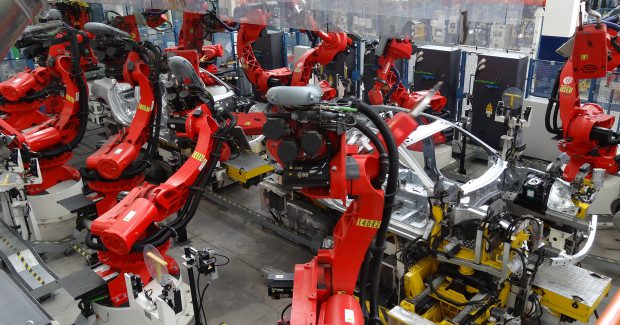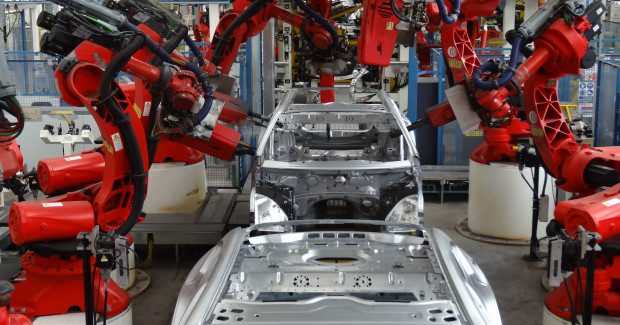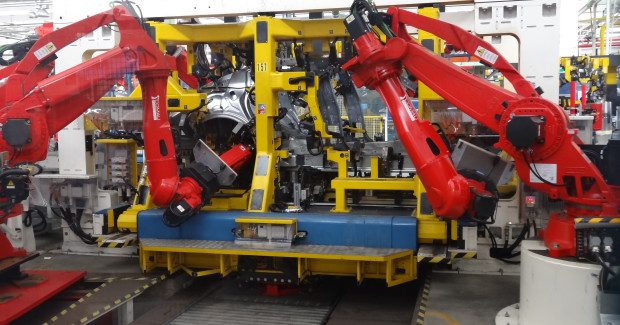Building Objects of Desire
With articulated robots and advanced software applications that can simulate every stage of production, Maserati leverages innovative robotic solutions from Comau to build the Quattroporte and Ghibli, two of the most prestigious models of luxury, sporty lines and aggressive engines.
Posted: March 21, 2015
Maserati, one of the most prestigious race and sports car manufacturers in the world, is a legendary symbol of “Made in Italy.” Its cars, famous for their luxury design, sporty lines and aggressive engines, have always represented an object of desire for any car enthusiast.
Internationally known for its famous Trident badge, Maserati was established on December 1, 1914, in Bologna, Italy. Today it operates in more than 40 countries around the world and continues to play a key role in the history and culture of sports cars. The brand represents more than just a symbol of elegance and style; it is truly a prestigious model of Italian technology and modernity.
THE MAKING OF AN INNOVATIVE PRODUCTION LINE
Crossing the threshold of the old Bertone plant located in Grugliasco is an exciting moment for anyone. The plant, which has now been renamed the Avvocato Giovanni Agnelli Plant, is a state-of-the art operation in management and technology that builds two of Maserati’s most popular models, the Quattroporte and the Ghibli. Plant manager Alberto Filippini describes these two automobiles with pride. “The Quattroporte is our flagship,” he smiles. “Launched in 2013, it can reach 307 km/h and is the fastest sedan in the world. It stands out for its elegance, finely crafted details and great comfort. The new Ghibli is a smaller sedan characterized by its well-defined, sporty and curvy lines.”
An examination of how these two luxury cars are built must start with the sheet metal department and the body shop assembly lines. “The Grugliasco plant has a production capacity of 50,000 vehicles per year,” explains Filippini. “We currently make 150 vehicles a day over two working periods. The cycle time of the sheet metal working phase is around 316 seconds, which means the line can build nine bodies per hour.”
The main feature of the line is its flexibility, as Renzo Novara, who is responsible for the sheet metal working department, explains. “Depending on the production needs, it is possible to program the line to automatically determine whether the piece is for the Quattroporte or Ghibli,” he says. “This is important because the bodies of the two models differ substantially in terms of the length of the chassis and the related components. Total flexibility of the line means that it is able to produce one of the two models, or both, in a continuous flow, according to the requests.”
To better understand why this level of flexibility is strategic for a company like Maserati, it is necessary to explore the line configuration in more detail. The first section of the sheet metal working line is where the high-strength steel and die-cast aluminum components, all of which have been fully tested and controlled, are received and hand assembled to build the so-called body. This element consists of the front framework (upon which the engine and all the related mechanical components are mounted), the central floor (the first row of seats, tunnel, etc.) and the back framework (the second row of seats and trunk).
After the frame is finished, it moves to the second section where the process is fully automated by 86 robots, 82 of which are made by Comau. These robots perform a wide range of operations including, welding, part handling, riveting, Tucker stud installation, roller hemming (the process of folding the flanges of the metal sheets), and more. The strength of the line, according to Novara, is largely due to robots from Comau SpA (Turin, Italy) which perform the complex operations of body shop line with extreme precision.
Once the automatic cycle starts, each chassis is processed in sequence by the various industrial robots. These robots perform spot welding on one hand while inserting subcomponents (brake hoses, underbody parts, wiring, etc.) as well as the closing elements, such as side and top clamp brackets, rivets and Tucker studs. Once completed, the chassis goes into to the section where the body is added. This operation is performed in ‘double layer,’ or better, in ‘parallel.’ In a first station, the skeleton, which is the internal part of the side, is fastened, while in the subsequent phase, the so-called ‘outer skin’ is added.
This cutting-edge technology improves accessibility and facilitates the operations performed by the robots in the welding stages and in the positioning of the references and clamping elements. In addition, the technology minimizes the number of slots, which makes the vehicle quieter and more stable. The Comau robots have a double function in this section. They weld and, by changing the robot head, they also perform the other activities that are needed to complete the assembly according to predetermined sequences. Such activities include handling and positioning of the different pieces, spreading the semi-structural adhesive on the chassis, and more.
Novara explains the process in more detail. “In the ‘double layer’ stations where the body is composed, the line can handle both the long chassis of the Quattroporte and the shorter Ghibli chassis,” he says. “In other words, it is here that the line proves its flexibility, given that it is able to produce both car models according to the requests, in a continuous flow and without interruptions. After the assembly of the outer skin for the sides, each piece continues to the sheet metal working phase for the measurement and verification operations.”

















